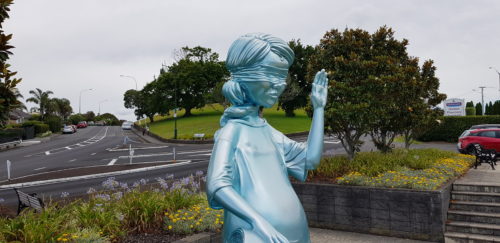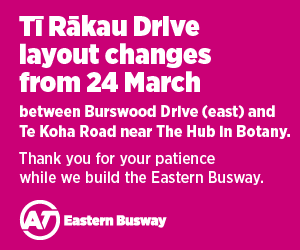
Something big, bright and blue has popped up in a popular Howick reserve and has received mixed reactions from the community.
Just before Christmas, Howick’s Crawford Reserve welcomed a large semi-permanent artwork called Kid Justice by artist Erin Forsyth.
The blue monument, which cost $55,000, was prompted by the recently-celebrated 125th anniversary of women’s suffrage and also fills a gap in Howick’s public art collection, says Auckland Council Manager Arts and Culture Richard McWha.
Emerging female artists were called to respond to the underlying themes of suffrage in a contemporary way.
“Public art projects are just one way that we can support artists to express themselves, develop their arts practice and provide experiences for our communities,” says McWha.
McWha says the monument was erected in the Howick area to acknowledge the significance of the site to suffrage and as a place with a history of female leadership.
The Kid Justice artwork rests on a plinth which has been designed as a permanent foundation, on which to install a changing collection of art that responds to both contemporary and historic themes.
During artist Erin Forsyth’s research of women’s suffrage, black and white cartoons emerged as an essential aesthetic associated to the movement.
Two images in particular stood out: a woman striving to push a cumbersome boulder uphill into parliament (after Sisyphus) and a reoccurring blindfolded figure of Justice.
The colour blue was chosen for the blue stockings worn by and associated with the women’s rights movement, Forsyth says.
“The particular shade and finish is intended to be highly reflective of the surrounding environment and respond to shifts in the weather. It is also intentionally playful, mimicking the colour of metals traditionally used for figurative sculpture once exposed to the elements.”
While Forsyth was scoping for her initial concept, she connected with the kaitiaki (guardian) of the Emilia Maud Nixon Garden of Memories to learn more about the local history of Howick.
During this time, the concept of kotahitanga (unity) began to emerge as a central theme for the work.
“We talked about how social issues may be confronted by future generations. Kid Justice developed naturally in response to our korero, a young person, a Governance, upholding equality for all people, looking toward an unseeable future,” Forsyth says.
However the monument has taken some getting used to for many residents.
Community members took to social media to express their confusion about what the monument signified, why blue was chosen as its colour and how much money was spent on it.
Some said on a public Facebook community page that the artwork was an “eye-sore” and a “waste of money.”
Others said Auckland Council should have had greater consultation with the community before erecting the artwork.
However many have supported the monument and have said they are proud Howick was chosen to feature an artwork with such significant meaning.
One woman said she was disappointed to see so many women complaining about an artwork that was created to “celebrate women’s suffrage.”








